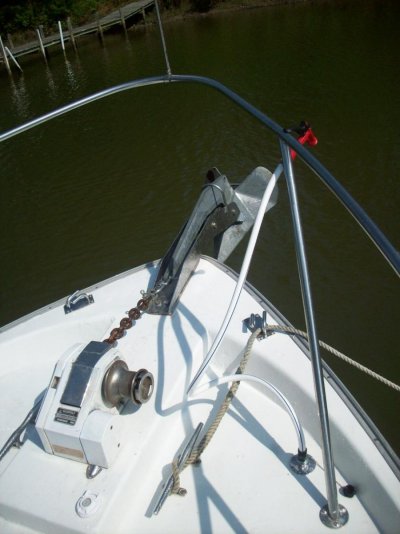BruceK
Moderator Emeritus
- Joined
- Oct 31, 2011
- Messages
- 13,559
- Vessel Name
- Sojourn
- Vessel Make
- Integrity 386
We have just one "Up" deck mounted footswitch to recover our anchor/rode. No helm or other switch.
The switch fails every couple of years, despite sealing it as well as I can during install. Dis/re connecting power requires a lot of unwelcome boat yoga. Switches cost $ 40 for the anonymous Taiwan made model, or $60 for a Muir "Waterproof" identical to the Taiwan version(DO NOT drink the bubble tea in Taipei, and don`t ask why).
Yesterday, armed with a new switch, I found the inside of the "cup" part of the switch full of dirt/plant like fibres. Enough to stop the plunger pin making contact in the closed area below. I cleaned out the muck,no improvement,then recalled advice to deluge the plunger/pin with WD40. Which I did, several times,noting it drained away, meaning the "cup" can drain into the closed contact area. Partner goes below and finds similar muck exiting below, there are drains in the cup to allow flow through. Gradually I start to get contact. Windlass switch off, I rotate the plunger pin while pressing it, and squirt more WD40. Activating the breaker, I get reliable immediate contact,normal service restored. New switch goes into Spares box.
Moral of the story: if you have one, play around with the switch, it may not need replacing.
Switch looks like this, note domed rubber cover detaches:
https://www.grabyourtackle.com.au/p...tch-for-winch-covered-new?variant=19814354951
The switch fails every couple of years, despite sealing it as well as I can during install. Dis/re connecting power requires a lot of unwelcome boat yoga. Switches cost $ 40 for the anonymous Taiwan made model, or $60 for a Muir "Waterproof" identical to the Taiwan version(DO NOT drink the bubble tea in Taipei, and don`t ask why).
Yesterday, armed with a new switch, I found the inside of the "cup" part of the switch full of dirt/plant like fibres. Enough to stop the plunger pin making contact in the closed area below. I cleaned out the muck,no improvement,then recalled advice to deluge the plunger/pin with WD40. Which I did, several times,noting it drained away, meaning the "cup" can drain into the closed contact area. Partner goes below and finds similar muck exiting below, there are drains in the cup to allow flow through. Gradually I start to get contact. Windlass switch off, I rotate the plunger pin while pressing it, and squirt more WD40. Activating the breaker, I get reliable immediate contact,normal service restored. New switch goes into Spares box.
Moral of the story: if you have one, play around with the switch, it may not need replacing.
Switch looks like this, note domed rubber cover detaches:
https://www.grabyourtackle.com.au/p...tch-for-winch-covered-new?variant=19814354951
Last edited:


